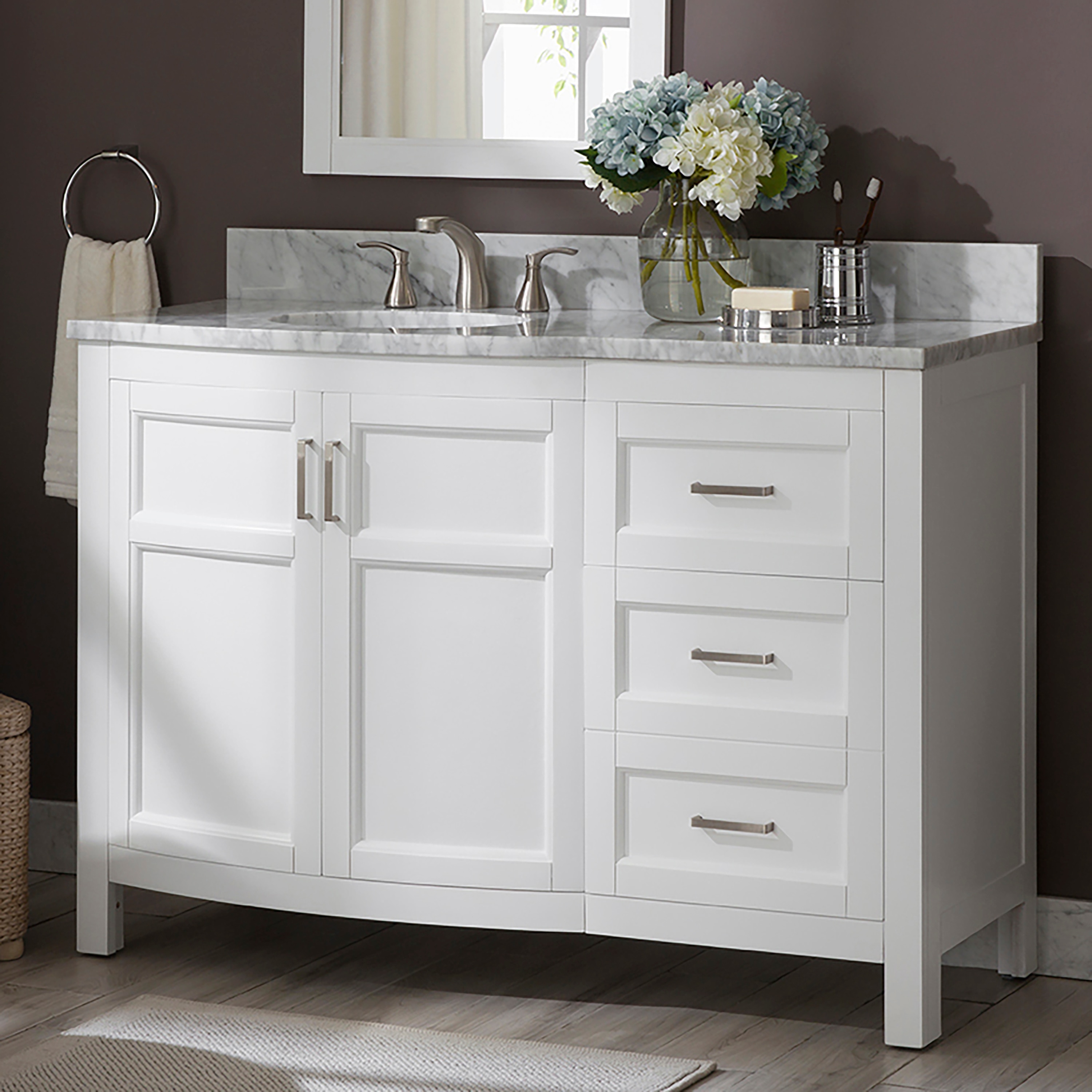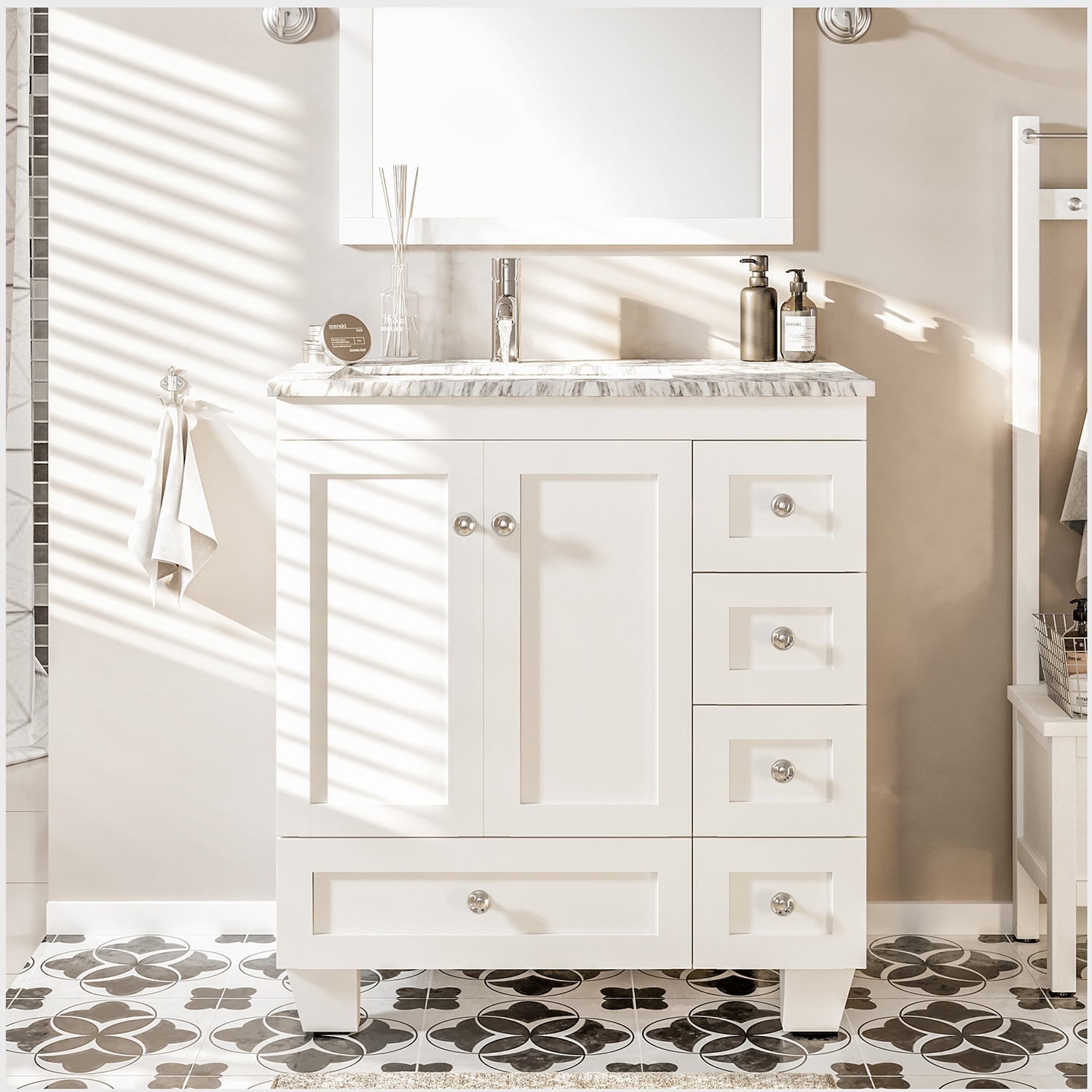Understanding 28 Inch Floating Bathroom Vanities

A 28-inch floating bathroom vanity is a stylish and practical choice for smaller bathrooms. It offers a compact footprint, maximizing space while providing ample storage. This type of vanity is typically wall-mounted, creating an illusion of spaciousness and a modern aesthetic.
Key Features of a 28-Inch Floating Bathroom Vanity, 28 inch floating bathroom vanity
The defining characteristic of a floating vanity is its lack of legs. Instead, it is mounted directly to the wall, giving the appearance of floating. This design element contributes to the modern and minimalist look that these vanities are known for.
A 28-inch vanity provides a compact size that is ideal for smaller bathrooms. It typically includes a single sink and storage space, making it perfect for individuals or couples. Despite its size, it can offer ample storage solutions with drawers, shelves, or cabinets, allowing you to keep your bathroom organized and clutter-free.
Advantages of Floating Vanities
Floating vanities offer several advantages over traditional cabinet-style vanities. They are:
- Space-saving: Floating vanities create an illusion of more space, making smaller bathrooms appear larger. This is due to the absence of legs, which often clutter the floor area.
- Easy to clean: The open space beneath the vanity makes cleaning the floor underneath much easier. You can easily sweep or mop without having to move furniture.
- Modern aesthetic: Floating vanities contribute to a modern and minimalist bathroom design. Their sleek lines and clean look create a contemporary and sophisticated feel.
- Versatile: Floating vanities come in a variety of styles and materials, allowing you to choose the perfect option for your bathroom decor. You can find them in traditional, modern, contemporary, and farmhouse styles.
Materials Used in 28-Inch Floating Bathroom Vanities
Floating vanities are crafted from a variety of materials, each offering unique advantages and aesthetics. Common materials include:
- Wood: This classic material is durable, warm, and offers a timeless appeal. Popular wood choices include oak, maple, cherry, and walnut. Wooden vanities can be stained or painted to match your bathroom decor.
- Laminate: Laminate is a cost-effective alternative to wood. It is resistant to scratches, stains, and moisture, making it a practical choice for bathroom vanities. Laminate comes in a wide variety of colors and finishes, allowing you to achieve a desired look.
- Acrylic: Acrylic is a durable and non-porous material that is resistant to scratches and stains. It is also easy to clean and maintain, making it a practical choice for bathrooms. Acrylic vanities are often available in a range of colors and finishes, offering versatility in design.
- Ceramic: Ceramic is a popular material for bathroom vanities, offering a smooth and elegant finish. It is also durable and resistant to moisture, making it suitable for wet environments. Ceramic vanities are available in various colors and designs, allowing you to find the perfect match for your bathroom style.
Styles of 28-Inch Floating Bathroom Vanities
Floating vanities are available in various styles to complement different bathroom designs. Some common styles include:
- Modern: Modern vanities are characterized by clean lines, simple shapes, and minimal ornamentation. They often feature sleek materials like acrylic, stainless steel, or glass, creating a contemporary and sophisticated look.
- Contemporary: Contemporary vanities share similarities with modern styles, emphasizing clean lines and minimalist designs. They may incorporate natural materials like wood, stone, or bamboo, adding a touch of warmth and organic appeal.
- Traditional: Traditional vanities feature ornate details, intricate carvings, and classic materials like wood or metal. They often have a more formal and elegant look, complementing traditional bathroom designs.
- Farmhouse: Farmhouse vanities are inspired by rustic charm. They often feature distressed wood, reclaimed materials, and simple hardware, creating a warm and inviting atmosphere.
Choosing the Right 28 Inch Floating Vanity: 28 Inch Floating Bathroom Vanity

A 28-inch floating vanity is a great choice for smaller bathrooms, as it saves space and adds a modern touch. But with so many options available, choosing the right one can be tricky. Here’s a breakdown of what to consider when selecting your perfect 28-inch floating vanity.
Bathroom Layout Considerations
Before you even start browsing vanities, you need to consider your bathroom’s layout. A 28-inch floating vanity can be a game-changer in a small space, but you need to make sure it fits. Here are some things to think about:
- Available Wall Space: Measure the wall where you want to install the vanity to ensure there’s enough room. Don’t forget to factor in any plumbing fixtures or electrical outlets that might be in the way.
- Door Clearance: If the vanity is near a door, make sure you have enough clearance for the door to open and close fully.
- Traffic Flow: You want to make sure there’s enough space to move around comfortably, especially if you have a small bathroom. Consider the placement of the vanity in relation to the toilet and shower.
Factors to Consider When Selecting a 28 Inch Floating Vanity
Here’s a checklist of important factors to consider when choosing a 28-inch floating vanity:
- Style: Do you prefer a modern, minimalist look, or something more traditional? The style of your vanity should complement the overall aesthetic of your bathroom.
- Material: Floating vanities are often made from wood, but you can also find them in materials like laminate or acrylic. Consider the durability and moisture resistance of each material.
- Finish: The finish of your vanity will affect its look and feel. Choose a finish that is easy to clean and matches the rest of your bathroom fixtures.
- Features: Some floating vanities come with built-in features like drawers, shelves, or even towel bars. Think about the storage needs of your bathroom and choose a vanity that meets them.
- Budget: Floating vanities can range in price from a few hundred pounds to several thousand. Set a budget before you start shopping and stick to it.
Choosing the Right Countertop Material and Sink
The countertop and sink are essential elements of your floating vanity. Here’s what to consider:
- Countertop Material: Popular countertop materials for floating vanities include quartz, granite, marble, and laminate. Quartz and granite are durable and stain-resistant, while marble is more luxurious but requires more maintenance. Laminate is a budget-friendly option.
- Sink: The sink should be a good size for the vanity and match the style of your bathroom. You can choose from undermount, top-mount, or vessel sinks. Undermount sinks offer a seamless look, while top-mount sinks are more affordable. Vessel sinks are a popular choice for adding a touch of style.
Maximizing Space with Storage Options
A 28-inch floating vanity may seem small, but you can still maximize storage space. Here are some tips:
- Utilize Drawers: Choose a vanity with drawers that are deep and wide enough to store all your essentials.
- Consider Open Shelving: Open shelves can add visual interest and make it easier to find items. You can use baskets or containers to keep things organized.
- Add a Mirror Cabinet: A mirror cabinet above the vanity can provide additional storage space and create a more spacious feel.
Installation and Maintenance

Installing a 28-inch floating vanity is a relatively straightforward process, but it requires careful planning and execution to ensure a secure and watertight installation. This section will provide a step-by-step guide for installing your vanity, along with essential tips for maintenance to ensure its longevity.
Tools and Materials
Before you begin the installation process, gather the necessary tools and materials. This will ensure a smooth and efficient installation.
- Level: Essential for ensuring the vanity is perfectly level.
- Measuring Tape: For precise measurements during installation.
- Pencil: To mark the wall for drilling and mounting.
- Drill: With appropriate drill bits for drilling into your wall material.
- Stud Finder: To locate studs in the wall for secure mounting.
- Screwdriver: For assembling the vanity and securing it to the wall.
- Caulk Gun: To apply sealant around the vanity to prevent water damage.
- Silicone Sealant: To create a watertight seal between the vanity and the wall.
- Safety Glasses: To protect your eyes during drilling and installation.
- Work Gloves: To protect your hands while working with tools.
- Floating Vanity: The 28-inch vanity you’re installing.
- Mounting Brackets: These will be provided with the vanity.
- Installation Instructions: Refer to the manufacturer’s instructions for specific guidance.
Installation Steps
The installation process involves several steps, starting with preparation and ending with securing the vanity to the wall.
- Prepare the Wall: Ensure the wall is clean, dry, and free from any debris or obstacles.
- Locate Studs: Use a stud finder to identify studs in the wall for secure mounting.
- Mark the Wall: Measure and mark the wall where the vanity will be mounted, ensuring it’s level.
- Install Mounting Brackets: Attach the mounting brackets to the wall using screws that are long enough to reach into the studs.
- Attach the Vanity: Carefully hang the vanity onto the mounting brackets, ensuring it’s level and secure.
- Seal the Vanity: Apply a bead of silicone sealant around the vanity to create a watertight seal between the vanity and the wall.
- Install the Sink and Faucet: Follow the manufacturer’s instructions for installing the sink and faucet.
- Connect Plumbing: Connect the vanity’s plumbing to the existing plumbing lines.
Ventilation and Waterproofing
Proper ventilation and waterproofing are crucial during installation to prevent moisture buildup and potential damage to the vanity and surrounding areas.
Ventilation: Ensure adequate ventilation in the bathroom to prevent moisture buildup. This can be achieved through a window, fan, or exhaust system.
Waterproofing: Use silicone sealant to create a watertight seal between the vanity and the wall. This will prevent water from seeping behind the vanity and causing damage.
Maintenance Tips
Regular maintenance is essential to keep your 28-inch floating vanity looking its best and functioning properly.
- Clean Regularly: Clean the vanity with a mild soap and water solution to remove dirt and grime. Avoid harsh chemicals that can damage the finish.
- Dry Thoroughly: After cleaning, dry the vanity thoroughly with a soft cloth to prevent water spots and mildew growth.
- Check Sealant: Periodically check the silicone sealant around the vanity for any cracks or gaps. Apply fresh sealant as needed to maintain a watertight seal.
- Tighten Screws: Over time, screws may loosen. Tighten them periodically to ensure the vanity is securely mounted.
- Inspect Plumbing: Regularly inspect the vanity’s plumbing for any leaks or drips. Address any issues promptly to prevent water damage.
